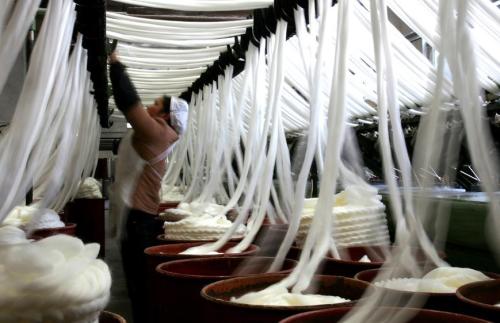 It was pointed out that the Chinese textile industry may be experiencing Buffett's situation 50 years ago. Fifty years ago, Buffett purchased a large U.S. textile company because of a very cheap price. With no way to withstand the low-cost emerging market competition, the US textile industry is becoming increasingly thin, and this textile company is not immune. Buffett took all his stops and could not make this company back to life. In the end, Buffett had to give up his investment in textiles and instead use cash flow to acquire shares in other private companies and listed companies. The name of this textile company is Berkshire Hathaway, the largest investment holding company in the world today. The original textile industry had disappeared from the company and its core business was insurance.
It was pointed out that the Chinese textile industry may be experiencing Buffett's situation 50 years ago. Fifty years ago, Buffett purchased a large U.S. textile company because of a very cheap price. With no way to withstand the low-cost emerging market competition, the US textile industry is becoming increasingly thin, and this textile company is not immune. Buffett took all his stops and could not make this company back to life. In the end, Buffett had to give up his investment in textiles and instead use cash flow to acquire shares in other private companies and listed companies. The name of this textile company is Berkshire Hathaway, the largest investment holding company in the world today. The original textile industry had disappeared from the company and its core business was insurance. 50 years later, the US textile industry seems to have regained its advantages in terms of costs and successfully attracted investment from the overlord China, the global textile industry. According to reports, Zhejiang Keer Group Co., Ltd., a leading cotton textile company, will open its first overseas factory in Lancaster County, South Carolina, with a total investment of 218 million U.S. dollars. The first phase of the project will begin in February 2014 and will be commissioned in October 2014.
The textile industry has always been seen as a labor-intensive industry. When labor costs continue to rise, textile companies have the incentive to move factories to countries and regions with lower labor costs. This has also led to the continuous shift of the global textile industry center: The United Kingdom after the United States — the United States after independence — the emerging market country after World War II — China. Nowadays, with the rising cost of labor in China, more and more Chinese textile companies have invested in factories in Vietnam, Cambodia, Indonesia and other Southeast Asian countries.
It seems puzzling that cotton spinning companies are shifting to the United States where labor costs are higher. What advantages of the United States have attracted Zhejiang Cole? The answer is the price of cotton. It was the huge price difference between China and the United States that attracted Cole to build a factory in the United States. Cole calculated that the new plant in the United States had an annual cotton consumption of 150,000 tons and employed 500 people. The company's domestic labor costs about 50,000 yuan per person per year, while the United States needs 200,000 yuan, but domestic labor costs are rising year after year. The United States has maintained this level for 20 years. Even if the trend of shrinking wages between China and the United States is not considered, the current wage gap does not allow Kohl to pay an additional 75 million yuan each year. However, the average price of U.S. cotton is 5,000 yuan less than that of domestic cotton. In this case, the cotton price will save 750 million yuan. Double the wages of U.S. workers is enough to cover.
Some people may have doubts about the direct import of US cotton, and the factory is still built in China. This can also make use of relatively cheap domestic labor. However, at present domestic restrictions on cotton imports, when the spread between domestic and foreign markets is large enough, capital may be used to directly go abroad to open factories and purchase on the spot. In fact, companies in developed countries face the same temptation to invest abroad in the face of the temptation of foreign cheap labor.
In order to protect the interests of cotton farmers and restrict cotton imports, the result may not be beneficial to the domestic textile industry. This disadvantage manifests itself in three aspects: one is that the capital of the textile industry flows abroad; the other is that textile companies that remain in the country cannot compete with international opponents due to high costs; and the other is that restricting the import of foreign cotton may lead to foreign countries. Trade retaliation. Cotton is a raw material for the textile industry. If cotton protectionism is not conducive to the domestic textile industry, it also means that the demand for domestic cotton has been greatly reduced. Demand has weakened, and the price of domestic cotton has been difficult to maintain. Ultimately, it is the interests of cotton farmers.
100% Polyester Microfiber Fabric Printed
Pigment Printing Fabric,Polyester Bed Sheet Fabric,Polyester Microfiber Fabric Printed,100 Polyester Microfiber Fabric Printed
ZHEJIANG HONGFENG SCI-TECH CO., LTD , https://www.hfmicrofiberfabric.com
![<?echo $_SERVER['SERVER_NAME'];?>](/template/twentyseventeen/skin/images/header.jpg)